I have covered a lot of Wolff’s pencils on this blog, but I’ve held off on the biggie, the pencil that ended up becoming the new company name, the ‘Royal Sovereign’.
I’ve tried to work out some date ranges for the various versions of the pencil, however, as you’ll see, most of the box designs changed slower than the pencil designs and so almost every box design had at least two versions of pencil design. This post therefore comes with a (large) health warning – a lot of guesswork was needed to help fill some gaps in my research.
The Royal Sovereign appears to have been Wolff’s attempt to produce a flagship competitor to pencils like L&C Hardtmuth’s Koh-i-noor 1500 pencil, which was now available in 19 degrees and famous for the yellow polish. My research suggests that the Royal Sovereign was introduced in 1912 as a direct replacement to the Wolff’s ‘Toughened Lead’ Pencils and it joined the standard range alongside the Bank of England pencil and the Spanish Graphite pencil. I’ve written about both these pencils previously so follow the links if you want a bit more background on these.
I think this excerpt from the Southern Reporter gives a nice summary of Wolff’s intentions with the Royal Sovereign pencil:
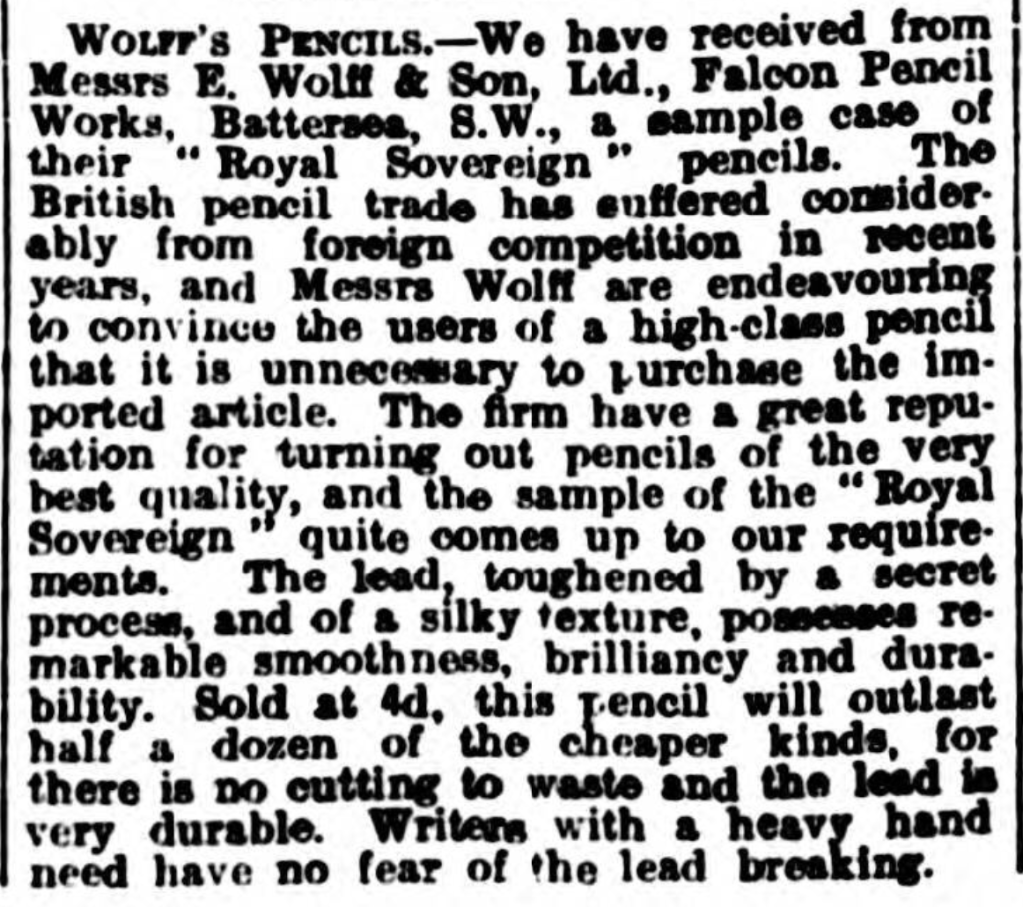
The Toughened Lead was still being advertised as the Flagship pencil of Wolff’s standard line-up in 1911, as the below advertisement from the Daily Telegraph & Courier (London) of 25 May shows:

The drawing below from an advertisement in the Civil & Military Gazette (14 June 1912) is one of the the few images of the box design for the Toughened Lead pencils.

The widest degree range Wolff had at this point in time was the Toughened Lead Pencils, ranging from 4H to 3B. The Royal Sovereign range had a more expansive range of 6H to 6B. It’s interesting that they retained the ‘toughened lead’ tag as a feature rather than the model name. The grades and their level of softness can be found when you open the ‘slide’ boxes:

The Toughened Lead’s polished cedar finish was switched to a new ‘Royal Scarlet’ polish. The Royal Sovereign retained the hex shape of the Toughened Lead (unlike the Leighton which was the flagship round pencil).
The patriotic name was not a random choice; there was a lot of competition coming from the Austrian and German makers and the British pencil makers really pushed the ‘British pencils for British people’ angle. This gained momentum following the outbreak of WWI, but it was already a thing before then. The advert below from the Westminster Gazette of Wednesday 05 June 1912 threw in two more ‘Royals’ just to help get the message home:

This expanded range and high quality finish was only made possible with advancements in pencil manufacturing. In 1908, Wolff filed a patent for automating the pencil making process (GB190802151A).
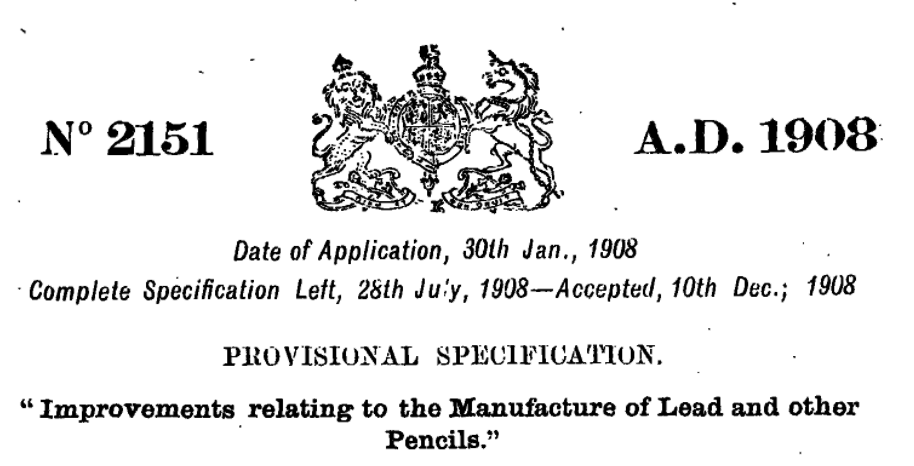
The process of pencil making used to involve gluing the leads between the two pieces of wood and gluing together by hand. Wolff’s new process involved the use of pre-sized slats of wood which passed through a machine which would cut the groove into the slat. Glue would then be added to the groove and then the leads would be inserted and glued into place. The slats would finally be cut and turned into pencils. This resulted in huge efficiencies and reduced labour costs.

The box design below is what I am taking to probably be the first box design of Royal Sovereign pencils, however, I believe that there may have been two variants of the pencil that came in this box.
BOX 1

If you look at the back of the box (below), it has the ‘E. Wolff & Son Ltd’ name. Before the incorporation as a limited company, E Wolff & Son was trading as a partnership under the moniker ‘E. Wolff & Son’. This partnership usually included the word ‘manufacturers’ after the official partnership name. If you look back at the Toughened Lead box above, you can see this to be the case.
BOX 1

The Gazette notes that from March 1911, the partnership of E Wolff & Son. was to be dissolved. It appears that Angelo Wolff would then run the firm as a sole proprietorship under the same name. Angelo would then go on to register the firm as a limited company, ‘E. Wolff & Son Ltd’ and sit as its chairman.

By May 1912, E Wolff & Son is operating as a limited company, as the advertisement below for ‘new’ Royal Sovereign pencils shows. It seems that there was an extremely short window of time when the Royal Sovereign pencil was manufactured, but the ‘E Wolff & Son’ Limited Company was not yet incorporated and therefore could not be printed on the pencils.


Therefore if you come across a Royal Sovereign pencil with ‘E. Wolff & Son Manufacturers’ stamped on it, I believe that they were the first run, and at that made for less than a year between 1911 and 1912. Looking at the advertising, it’s likely that these versions overlapped with the end sales of the ‘Toughened Lead’ pencils.
I’ve always wondered where they got the “Falcon’ factory name from, as it was located on York St in Battersea. When researching this post, I came across a 1 March 1881 Gazette entry for the dissolution of an old stationers “Smith & Wolff” of which Angelo Wolff was a partner (above). This old stationers was located on Falcon Street off Aldersgate street. I’m taking a bit of a leap here, but I wonder did Angelo adopt the Falcon name as a bit of a personal reminder of his old venture…

The photo above shows three stamped faces of the same version (what i’m calling the ‘first run’) of the pencil. The pencils with the ‘E. Wolff & Son. Manufacturers’ stamping are the only pencils in the Royal Sovereign timeline with three faces stamped. Over time the pencils dropped down to two and finally one face stamping. On this model, I’ve seen 2B-6H. I’d like to see examples of the softer grades, particularly BBBBBB.
The two examples of early 1913 advertising below (one from Pall Mall Gazette and the other from the Westminster Gazette) suggest that the Royal Sovereign pencils are so good, you can actually tell that you are using one just by the sound. The toughened lead process supposedly created a particularly smooth writing experience that was not available until now.


The next design of pencils have the ‘E. Wolff & Son Ltd’ company name stamped on the barrel. Unlike the slightly earlier models, they only have two faces stamped with lettering. Apologies for the slightly crummy pictures of the black lettering versions, not an easy thing to get a good photo of.


I also have the same version with gold stamping instead of black. I am almost completely sure that the black lettering used to be gold and the stamping has simply worn off, but there is no real way of telling 100%.
What is important is that the pencils (both black and gold versions) have ‘By Appointment to H.M. The King’ on the barrel, so these were manufactured whilst (i) George V was alive, and (ii) E Wolff & Son was a limited company.
Therefore I date these pencils from 1912-1920, but i think there may have been a small gap in production of a few years during WWI, particularly during 1917 and 1918 (a combination of rationing and production being diverted to the Government departments).



The advert in the Daily Mirror from 21 May 1913 includes the same stamping layout as the actual pencil above. The advert makes reference to the Ltd company and so this is definitely the pencil they are referring to.
The adverts below are also both from 1913 (L – Pall Mall Gazette – Tuesday 18 February 1913 / R – Westminster Gazette – Thursday 30 January 1913)


On 19 November 1920, the Gazette reported that the E. Wolff & Sons Limited was to be dissolved. By 13 May 1922, the liquidators had done their jobs and the limited company had formally been dissolved.
The reason for the dissolution was due to the incorporation of a new company in October 1920, the ‘Royal Sovereign Pencil Co Ltd’. The formation of the new company was due to the merger of two successful pencil companies – E. Wolff & Son Ltd and Arthur Johnson Ltd.


This merger was reported in both the Pall Mall Gazette on Wednesday 06 October 1920 and the Yorkshire Post and Leeds Intelligencer, also on Wednesday 06 October 1920. Following the merger, the Falcon Pencil Works at Battersea (which had been in operation from 1878) was closed and production was moved to the Britannia Works, Neasden, which was originally home to Arthur Johnson Limited’s pencil factory.
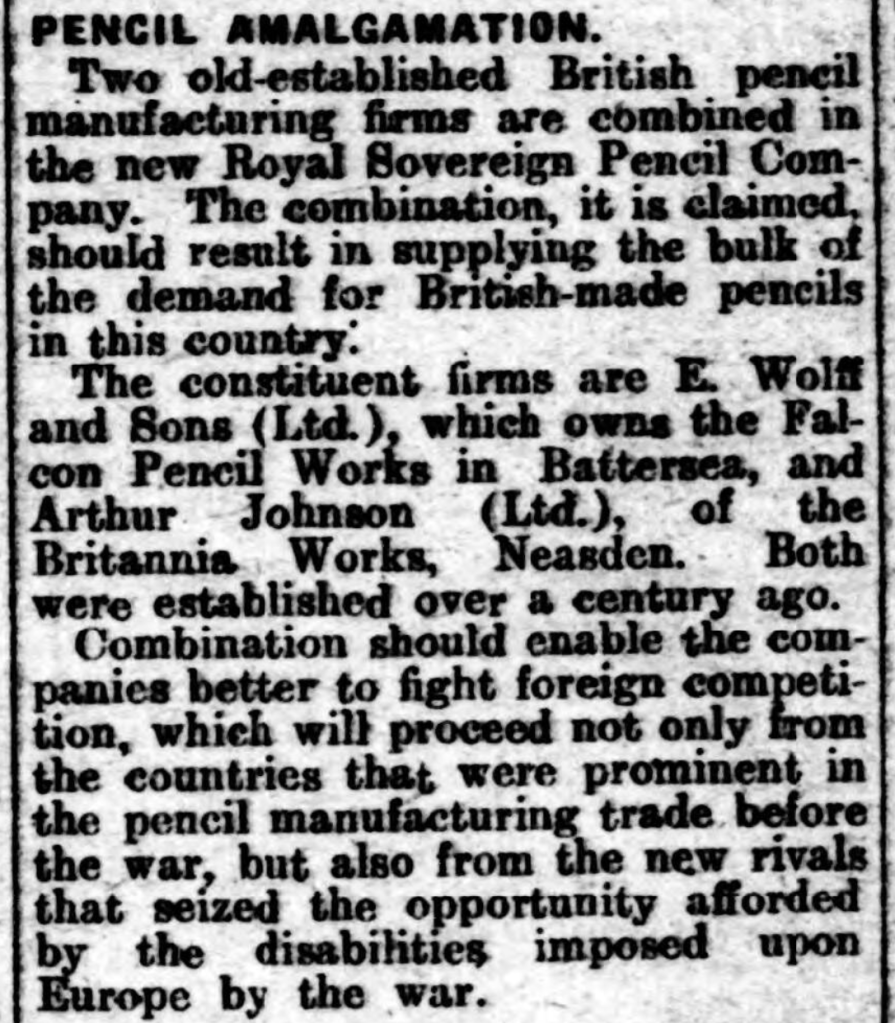
We have therefore arrived at another important date for your records – October 1920. By November 1920, the new company, the ‘Royal Sovereign Pencil Co. Ltd’ was putting their name on the adverts. Therefore, any pencil with ‘Royal Sovereign Pencil Co. Ltd’ branding, or the shortened ‘Wolff’s’ instead of the longer ‘E. Wolff & Son’ text was likely manufactured after this October 1920 date.
I believe that the “By Appointment’ stamped pencils below followed the formation of the Royal Sovereign Pencil Co. Ltd, therefore they were manufactured from 1920 onwards

To add a level of confusion, the boxes and advertisements didn’t make the change quite as quickly. If you look at the drawing of the pencil behind the lion below, the pencil still has the ‘E. Wolff & Son’ text and in fact, you can see a similar pencil drawing on later boxes too. I have never come across a pencil with this exact stamping (grade on the right-hand side of the pencil) and so I have reached the conclusion that this was just a mock-up of a pencil that was never actually made. If you know differently, let me know.

To gain the Royal Warrant, an item must have been supplied to the Royal Household for 5 of the previous 7 years. Further, under the Royal Warrant system in the UK, once the Royal Grantor dies, the Royal Warrant will become void and the company or individual will have two years to discontinue the use of the Royal Arms in connection with the business, provided there is no significant change within the company concerned.
E. Wolff & Son (first as a partnership and then as a Ltd company) was granted the Royal Warrant for King George V. Given there was no deemed significant change to the company, the Royal Sovereign Pencil Co. Ltd continued to hold this Warrant. George V dies in 1936, therefore the Royal Sovereign Pencil Co Ltd had had until 1938 to use the Royal Warrant on the pencil and box.
On 12 July 1938 the Gazette noted that the Royal Sovereign Pencil Co. Ltd had been granted the right to carry wording indicating that they held a Royal Warrant to the late king. By 1938 George VI was on the throne, given the swift abdication of Edward VIII, maybe he wasn’t a fan.

![]()
As an interesting aside, George V dies on 20 January 1936, therefore the Royal Sovereign Pencil Company Ltd can use the Royal Warrant until 20 January 1938 unless they get it re-approved. They didn’t get approval to use the ‘late king’ wording until 12 July 1938, therefore there was a period of roughly 7 months where they couldn’t use either wording on the pencils. So what did they do during this period? If you happen to have a box or pencil that might fit into that tiny window do let me know.
The box below does not yet have the new Royal Sovereign ‘lion’ branding on it. Therefore I believe this is the probably first box following the change from the ‘E. Wolff & Son Ltd branded’ box with the wolf on the front (see ‘box 1’ earlier in this post). Note the mock-up pencil drawing behind the ‘Royal Sovereign’ branding; as I discuss above, I do not believe this exact pencil model was ever made.
BOX 2

If you look carefully at the box above there are two key differences to help identify this version of the box. Firstly Royal Warrant has the complete “By Special Appointment To His Majesty The King’ wording around it. Second, the address on the box refers to ‘E. Wolff & Son Ltd, Falcon Pencil Works Battersea London SW’.

This particular box in my collection came with the HB grade below

Box 3 below still does not have the Royal Sovereign lion branding, however, you can see that the address has changed and now says ‘Royal Sovereign Pencil Co. Ltd London England’ instead of the Wolff address. The wording around the Royal Warrant has been shortened to simply ‘By Appointment’.
BOX 3


The box below still holds the Royal Warrant, but now also has the ‘lion’ Royal Sovereign branding.
BOX 4


You’d like to hope it would be as simple as that, but no, the Royal Sovereign Pencil Co. Ltd made two versions of this particular ‘lion’ branded box. The front of the box is the same, however, if you look at the back face, you can see that they swapped the Royal Standard and the Royal Sovereign lion Logo around. I’d love to be able to tell you when this swap happened, but honestly, I have absolutely no idea.
BOX 5


I have seen Royal Sovereign pencils with the arched ‘toughened lead’ stamping supplied in the box above so I’m going to pair them (I’ve also seen ‘By Appointment’ pencils in this box too). I have also seen ‘War Drawing’ pencils in this box and so I think this was the last box before the ‘austerity boxes’ (below).
Given the absence of ‘late king’ warrant, I’d place all three of these boxes before 1938.
BOX 6
It’s really quite difficult to tell the order of the ‘austerity boxes’, so you’ll have to take the next three with a pinch of salt. Boxes 6 and 7 both have ‘valuable salvage’ stamps so we know they are certainly war time in some shape or form, 1939-1944 seems a sensible guess (after they switched to the ‘late King stamping and before the pencil polish restrictions). Note that the pencil in the background of box 6 and 7 still says “E. Wolff & Son”.
Box 6 is very simple in design with its single flap opening and limited colour scheme:
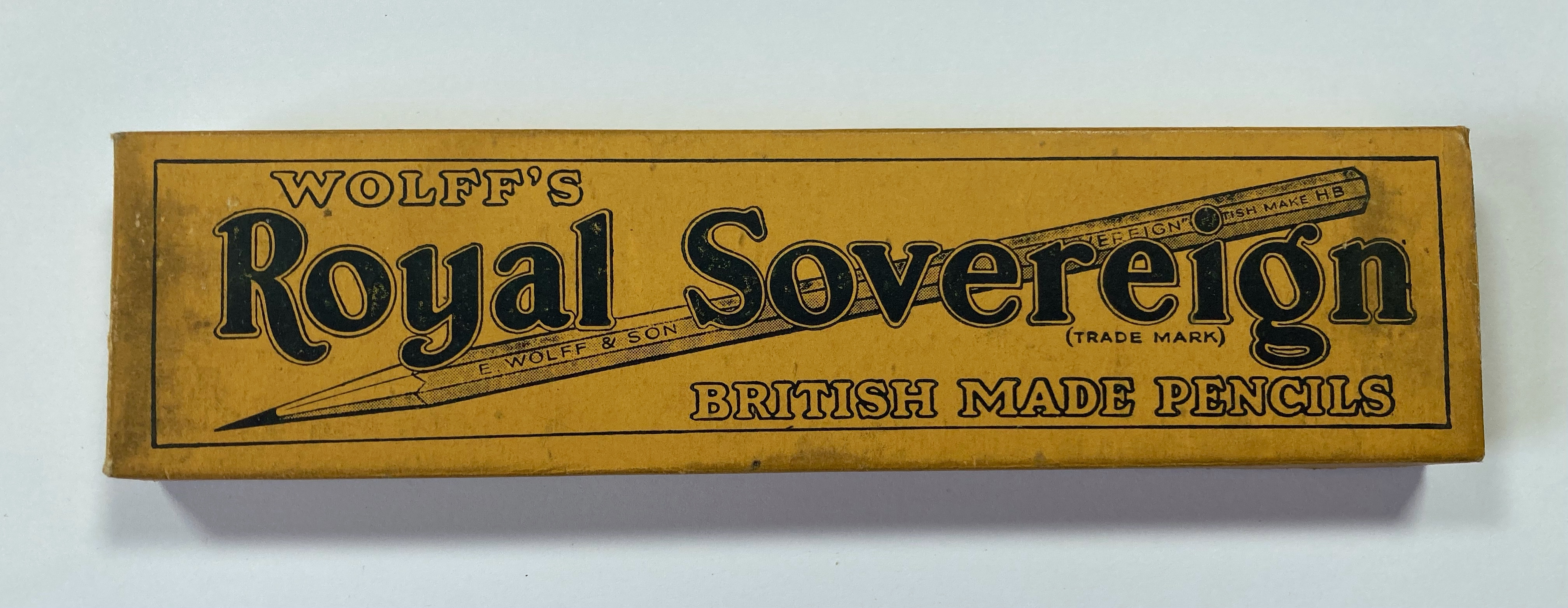
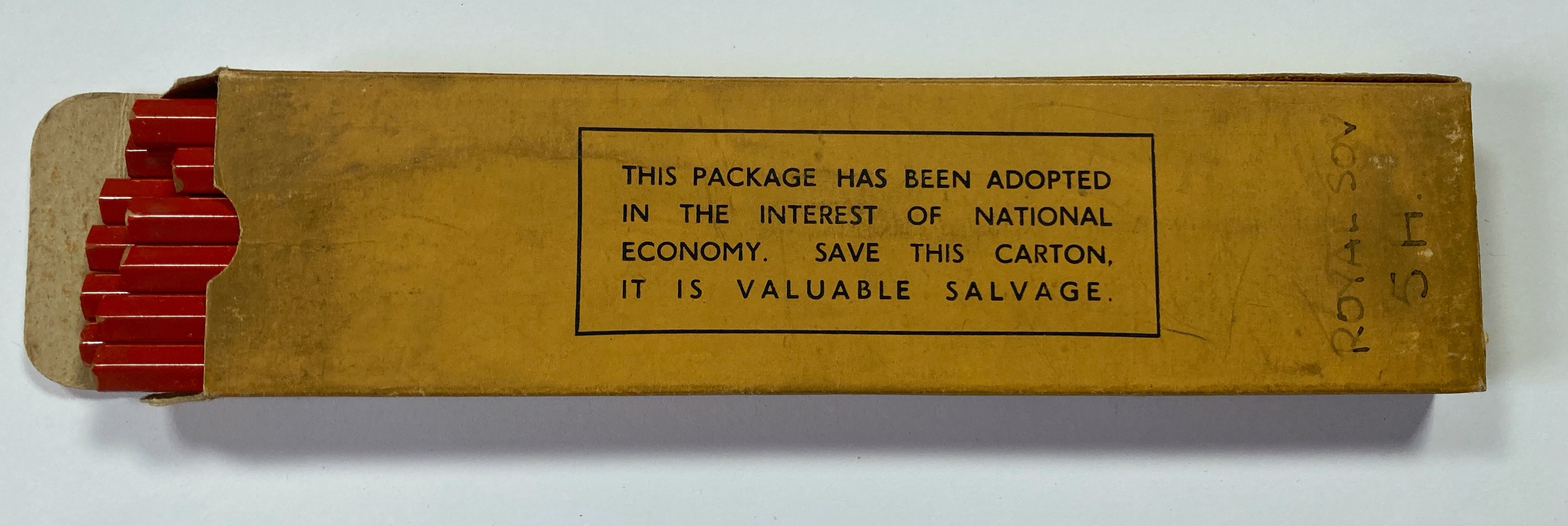
BOX 7
Box seven is very similar to box six in terms of colour scheme and salvage stamp, however, it is actually slight wider and uses more cardboard due to its sliding box design:


I believe that the Royal Sovereign with the arched ‘toughened lead’ stamping are probably the last versions before the factory expansion into Wales and feature in boxes 6,7,8 and 9.
![]()
BOX 8
Box 8’s design appears to have changed again for the final run of the London made pencils into a more ‘coffin’ style. You will note that the pencil drawing on the box behind the Royal Sovereign branding finally says ‘Wolff’s’ instead of ‘E. Wolff & Son’. We also have the ‘late king’ warrant wording. For these reasons I am placing the box 8 design after box 6 and 7, either

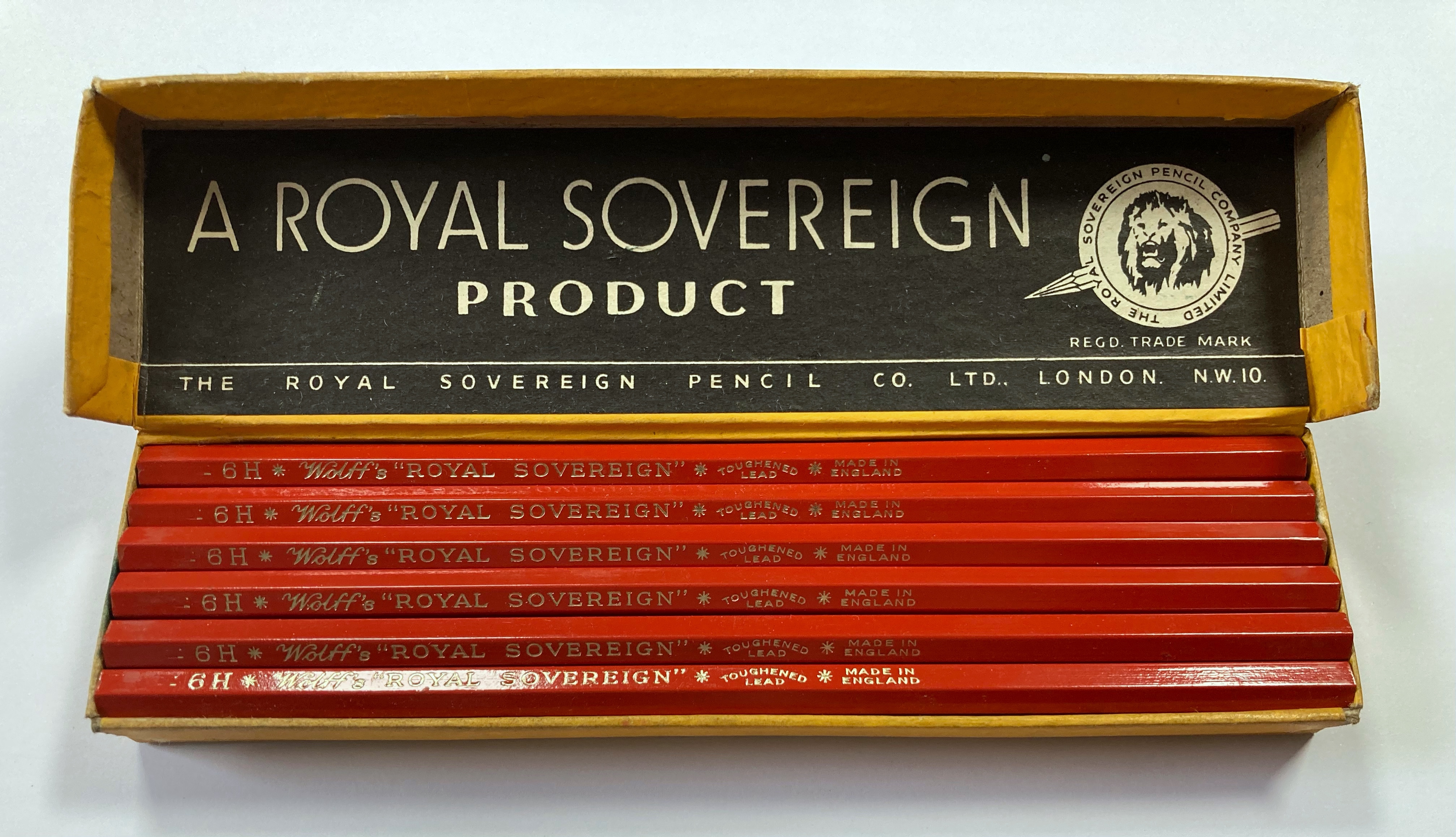
The use of polish/paint on a pencil for the UK market was restricted from 1944 to 1949 and so the plain wood Royal Sovereign ‘War Drawing’ pencil would have replaced the red Royal Sovereign pencil for these years.

BOX 9
So many boxes!
This particular example is really quite interesting as it has quite a fancy opening mechanism. In a way it reminds me of the Eberhard Faber 601 boxes with the pull tab.

We can see from the sides that the branding is heavily British-centric. Given that this box was probably produced just shortly after the war, it’s easy to understand why.


The patent number on the bottom of the box is still available to view here.
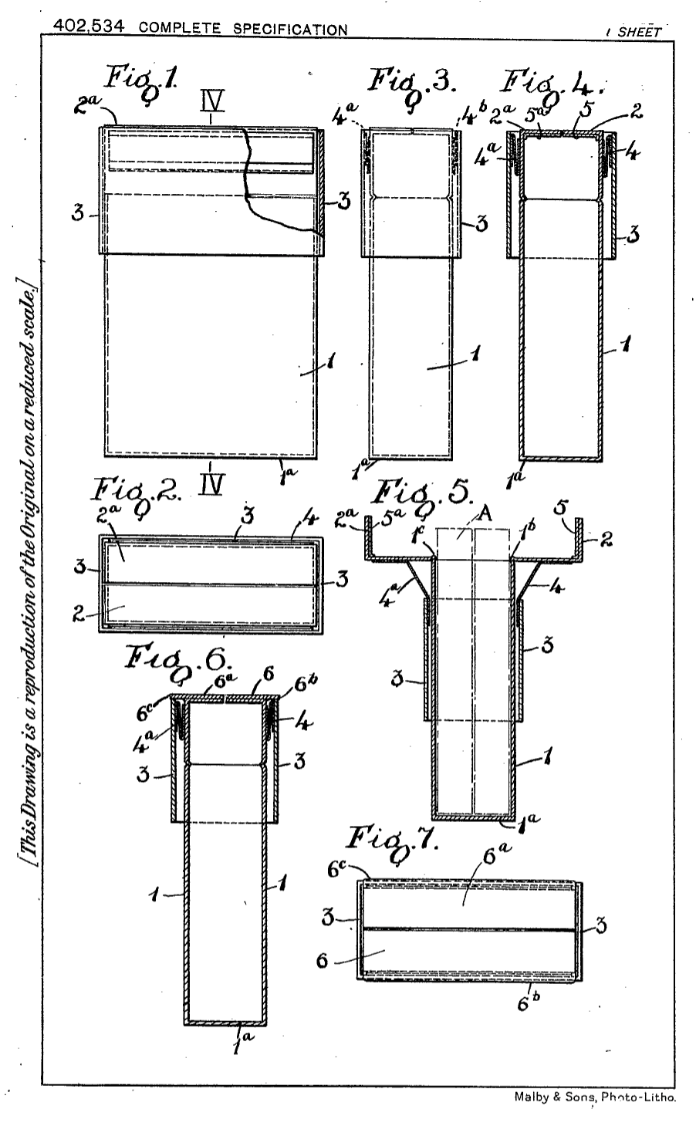
Whilst the design was not something Royal Sovereign came up with, they did clearly decide to use it for their pencils. The patent was filed in 1932 but I believe that the box is much newer than that.

Nice to see the fabric hinge still intact on this example:


The ‘Made in England’ stamping suggests these were still made in the Britannia Works factory in Neasden. I understand that by 1949, the Britannia Works factory was making Waterman Pens, but I think its probably likely the ‘pull down’ box was the last example coming out of that factory, so late 1940s if I had to guess.
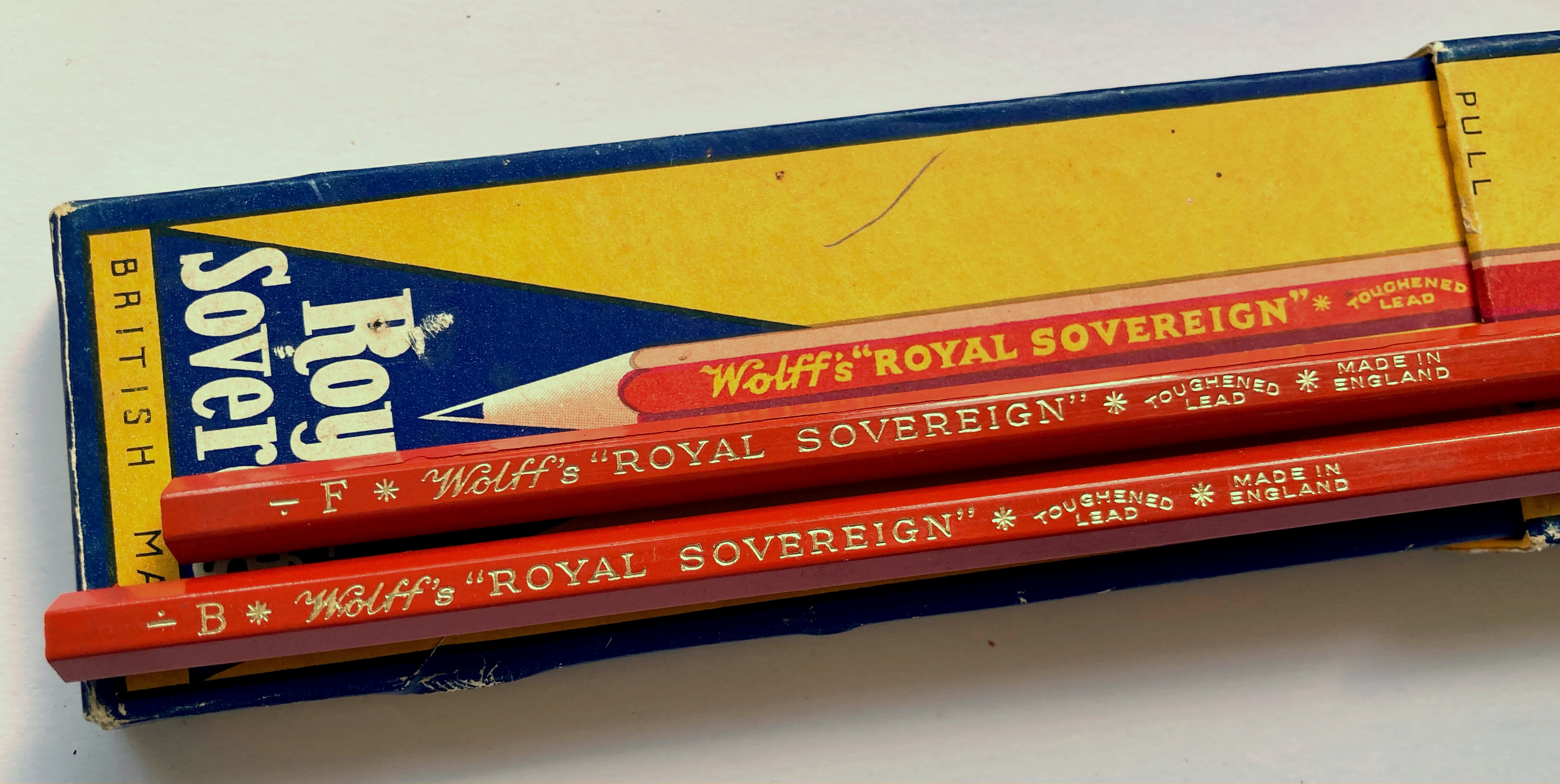
The arched ‘Toughened lead’ pencil was also made in the Welsh factory. You will note that the pencil now says ‘made in Great Britain” rather than “Made in England”. This is a good way of helping to date the pencil. I believe that this Welsh made pencil was either made between 1949 and 1950 if made for the UK market or between 1946-50 if made for the export market.
![]()
The Royal Sovereign pencil was eventually given a model number ‘5151’.

The Royal Sovereign Pencil Company Limited set up their pencil factory in Pontyclun, Wales in 1946. Expansion had been discussed in the 1920s however the war had brought a shortage of labour. South Wales was supposedly chosen due to it being an untapped resource of woman labour.
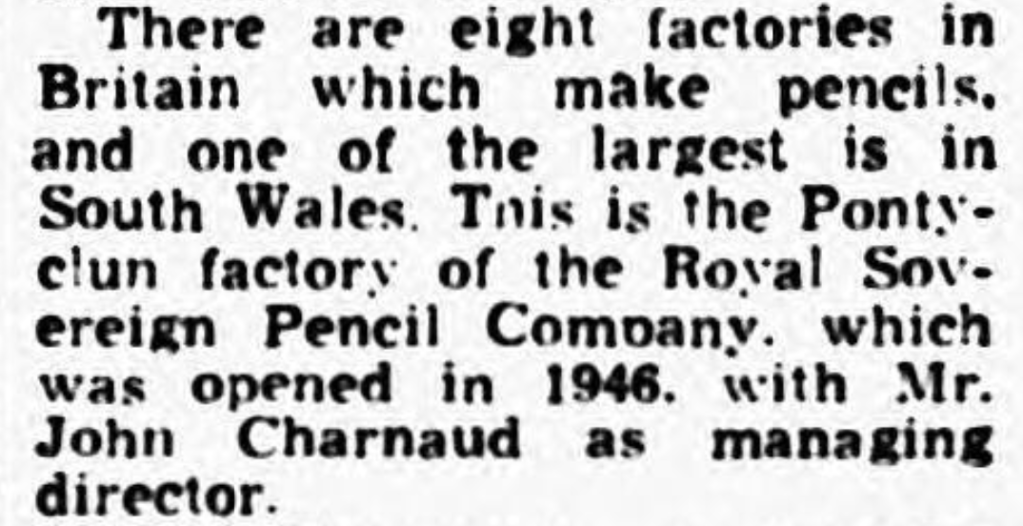
This advert from the Western Mail shows that as early as 2 May 1955 the metal tin was in production. You don’t have to be a master detective to work out where the pencils were being made…

I believe that under UK law, metal was still restricted in pencil making until 1 October 1949, therefore, I believe that this would be the earliest date the 5151 model could be sold in the tin. Given that the red polished finish would have also been restricted, I am taking a punt that the 5151 was produced from 1950 onwards as well (or maybe even 1951, saying as 51 features twice on the pencil?).
I do wonder what they were making between 1946 and 1949 in the Wales factory. Under the UK restrictions, a company could still sell non “War Drawing’ pencils outside of the UK, so perhaps they manufactured pencils for the export market.
BOX (TIN) 10

It is very likely however that anything stamped ‘made in England’ was made in the Britannia Pencil Works before 1946, whereas anything ‘Made in Gt. Britain’ was more than likely made in the Wales factory post 1946.
I am therefore dating any 5151s in a metal tin from 1950/51-1966(ish). I have seen some 5151s in the ‘austerity’ box before, and I think that these boxes were probably just being used up before the tins were put into production. I do not believe there is any difference between the pencils sold in the card or the tin.
The advert from the Western Mail on 30 January 1956 was one of the only adverts I could find which actually showed the ‘5151’ stamping on the pencil, but I have come across advertisements for the Royal Sovereign Pencil into the early 1960s, such as the advert on the right from August 1961.


The Gazette noted as late as 31 December 1965 that the Royal Sovereign Pencil Company Limited was still entitled to use the ‘late king’ Royal Warrant. Staedtler started to become involved with the factory from 1966 onwards, hence, I do not think that the Royal Sovereign model was produced after 1966.

So thats that, it looks like the Royal Sovereign model of pencil had a decent run, being produced in some shape or form from 1911-1966.
You will have noticed that a certain amount of guess work has been employed within this post. What I’d like to do is open this up to discussion. Do you have anything to fill in the gaps? I’d be keen on seeing various boxes with full sets in them to help try and pin down the crossover dates. Feel free to drop me a line in the contact form or comment below.